Paper quilling is a craft that involves rolling, shaping, and gluing strips of paper to create intricate designs and patterns. It’s a versatile and accessible art form that anyone can learn, regardless of skill level.
In this comprehensive guide, we will take you on a journey through the essentials of paper quilling. From understanding the basics to exploring advanced techniques, you’ll learn everything you need to know to unlock your creative potential.
Key Takeaways:
- Paper quilling is a craft that involves rolling, shaping, and gluing strips of paper to create intricate designs and patterns.
- This guide will take you through the essentials of paper quilling, from understanding the basics to exploring advanced techniques.
- Paper quilling is a versatile and accessible art form that anyone can learn, regardless of skill level.
- Whether you’re a complete beginner or have dabbled in quilling before, this guide has something for everyone.
- By the end of this guide, you’ll be equipped with the knowledge and skills to unleash your creativity through the art of paper quilling.

Introduction to Paper Quilling
Welcome to the enchanting world of paper quilling! This fascinating craft is perfect for beginners who are looking to explore their artistic potential.
Quilling, also known as paper filigree, is the art of rolling and shaping thin strips of paper into decorative designs. This craft has a rich history and has been practiced for centuries around the world.
To get started with quilling, you will need a few basic supplies. Don’t worry, they are easy to find and won’t break the bank. You’ll need:
- A quilling tool
- Quilling paper strips in various colors and sizes
- Glue
- A quilling board (optional, but helpful for beginners)
Once you have your supplies, it’s time to dive into the world of quilling techniques!
Essential Quilling Supplies
As a beginner in paper quilling, it can be overwhelming to determine what supplies you need to get started. Here is a list of essential quilling supplies that will help you create beautiful designs:
- Quilling paper strips in various colors and widths
- A slotted quilling tool
- Glue (choose a glue that dries clear and is not too thick)
- A quilling board with pins or a foam board
- Scissors
- A ruler
Most of these supplies can be found at your local craft store or online. When selecting quilling paper strips, choose a variety of colors and widths to add depth and dimension to your designs.
The slotted quilling tool is essential for making tight and uniform coils, while the quilling board helps you create consistent shapes for your designs.
Don’t forget to have a pair of scissors handy for cutting your quilling paper strips to the desired length, and a ruler to achieve precise measurements.
Invest in quality supplies and take good care of them, and they will last you a long time and help you produce stunning quilled pieces.
Getting Started with Quilling Techniques
Now that you have your quilling supplies ready, it’s time to get started with the basics. Here are the key techniques to master:
Tight Coils
The tight coil is the foundation of quilling and the most basic technique. To create a tight coil:
- Insert one end of the quilling paper strip into the quilling tool, leaving about 1 inch of paper over the end.
- Roll the tool towards you to create a tight coil.
- When the coil is complete, remove the tool and hold the coil in place for a few seconds before letting it go.
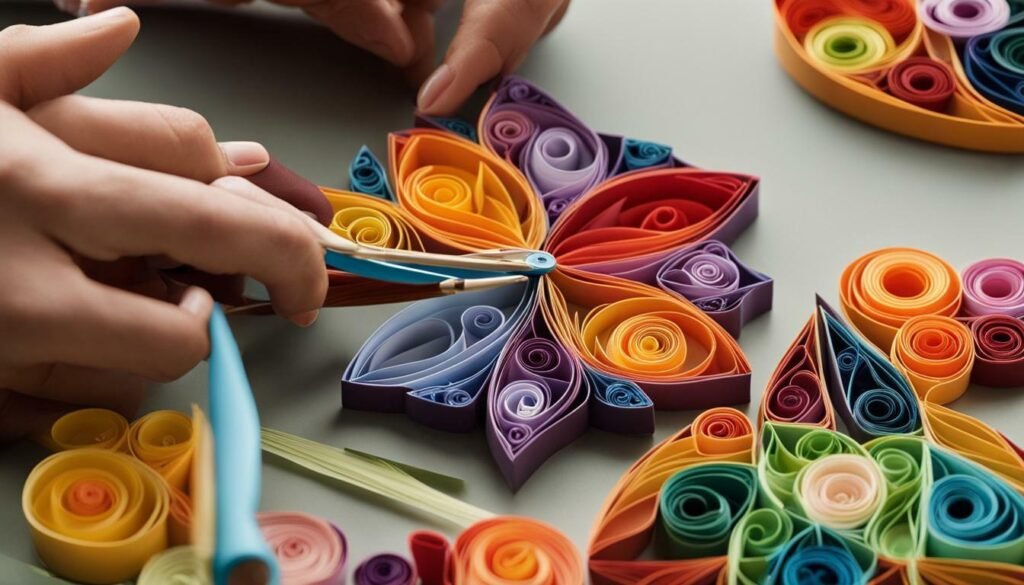
Once you have mastered the tight coil, try creating basic quilling shapes:
- Teardrop: Pinch one end of the coil to create a teardrop shape.
- Marquise: Pinch both ends of the coil to create a marquise shape.
- Half moon: Pinch one side of the coil to create a half-moon shape.
Gluing and Securing
Gluing and securing your quilled pieces is essential for creating durable and long-lasting designs. Here are some tips:
- Use a small amount of glue to avoid excess glue drying and making the paper curl or warp.
- Use a toothpick or fine tip applicator for precise glue application.
- Hold the pieces in place for a few seconds to ensure a secure bond before letting them dry completely.
With these basic techniques, you can create a variety of quilled designs. Practice and experiment with different colors, sizes, and shapes to unleash your creativity.
Understanding Quilling Patterns
If you’re looking to take your paper quilling to the next level, understanding quilling patterns is an essential skill. Whether you’re creating a simple design or a complex piece of art, mastering quilling patterns is key to making your project stand out.
Basic Quilling Patterns
- Basic shapes: Start with simple shapes like circles, squares, and triangles, which are perfect for beginners.
- Flowers: Flowers are a popular quilling motif, and there are many different techniques to create them. Petals can be shaped in various ways to give your flowers a unique look.
- Leaves: Leaves can be created using a similar technique to petals, and can be used to complement flowers or create standalone designs.
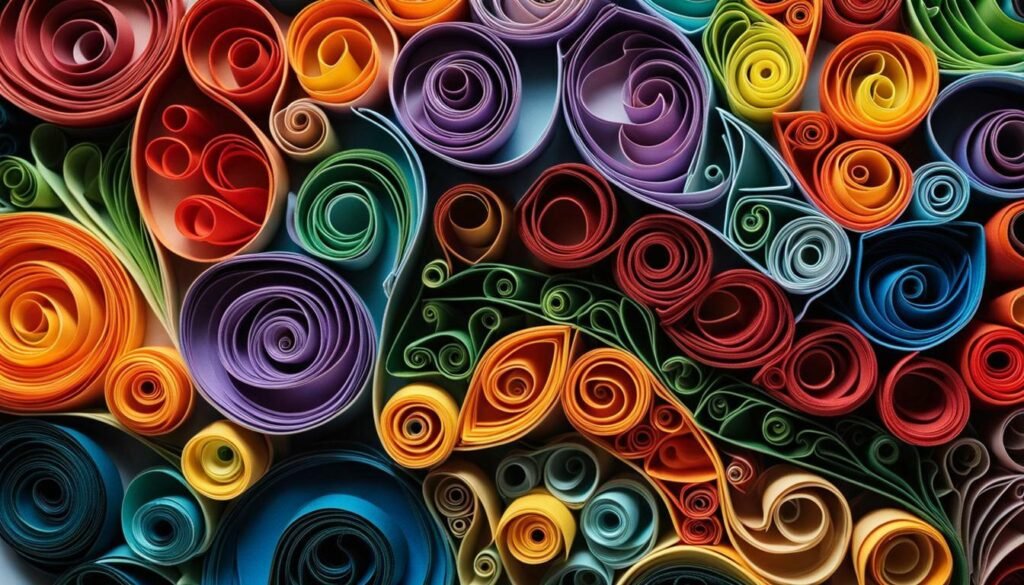
- 3D quilling: Adding depth to your quilling patterns is a great way to create a unique and eye-catching design. By using multiple layers of quilled shapes, you can create a three-dimensional effect.
- Quilling typography: Using quilled shapes to create letters and words is an impressive technique that requires a steady hand and lots of patience. It’s a great way to create personalized gifts or home decor.
- Quilling portraits: This is the ultimate challenge for advanced quillers. Creating portraits using quilled paper is a complex and detailed process, but the results can be breathtaking.
Interpreting Quilling Patterns
Once you’ve chosen a quilling pattern, it’s important to understand how to follow it correctly. Here are some tips for interpreting quilling patterns:
- Read the instructions carefully and ensure you understand each step before you begin.
- Pay attention to the shape and size of each quilled piece, as well as the colors used.
- Use a quilling board to help you create uniform shapes and sizes for your quilled pieces.
- Experiment with different color combinations and variations of the pattern to make it your own.
Exploring Advanced Quilling Techniques
Congratulations! You have now mastered the basic quilling techniques. It’s time to take your skills to the next level and explore advanced techniques. Here are some basic quilling techniques that you need to know before you proceed to the advanced ones:
- Rolling tight coils
- Creating basic shapes like teardrops and marquises
- Mastering the art of gluing and securing your quilled pieces.
Now, you’re ready to learn advanced techniques. Here are some techniques that you can try:
3D Quilling
3D quilling is a fun and exciting technique that allows you to add depth and dimension to your quilled designs. It involves creating multiple quilled pieces of the same shape and size, and then stacking and gluing them together to create a 3D effect. Here are the steps to create a 3D quilled object:
- Create several quilled pieces of the same shape and size
- Glue them together, placing the quilled pieces on top of each other to create the desired 3D effect
- Adjust the angles and shapes of the quilled pieces as needed to achieve the desired look
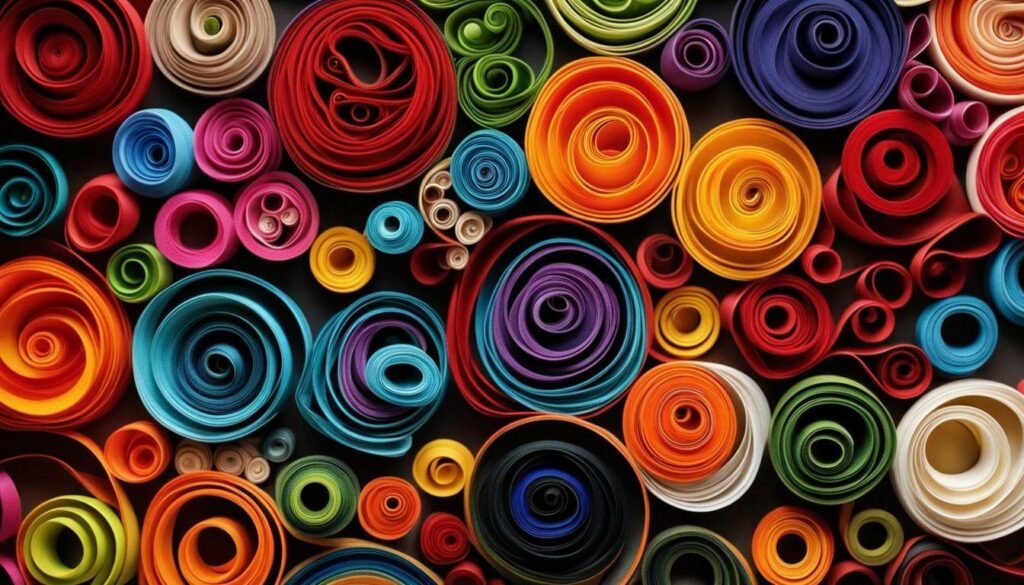
Combing and fringing are techniques that are used to create textured effects in quilling. Combing involves running a quilling comb through a strip of paper to create even ridges or waves. Fringing involves cutting slits into a strip of paper to create a fringed effect. Here are the steps to comb and fringe:
- For combing, run a quilling comb through a strip of paper to create even ridges or waves
- For fringing, cut slits into a strip of paper to create a fringed effect
- Roll or shape the paper as desired to create the quilled design
Quilling Jewelry and Home Decor Projects
Quilling isn’t just for paper crafting! You can use quilling techniques to create unique jewelry and home decor projects. Here are some ideas:
- Quilled earrings or pendants
- Quilled wall art or framed pictures
- Quilled flower arrangements or wreaths
Remember, these are just a few of the many advanced quilling techniques that you can try. Keep experimenting, pushing your limits, and discovering new ways to create stunning quilled designs!
Quilling Tutorial: Creating a Quilled Card
Are you ready to put your paper quilling skills to the test? Follow our step-by-step quilling tutorial to create a beautiful quilled card that will impress your loved ones.
Gather your supplies:
- Quilling paper strips in various colors
- Quilling tool
- Glue
- Quilling board
- Scissors
- Cardstock
- Markers or stamps for decorating the cardstock
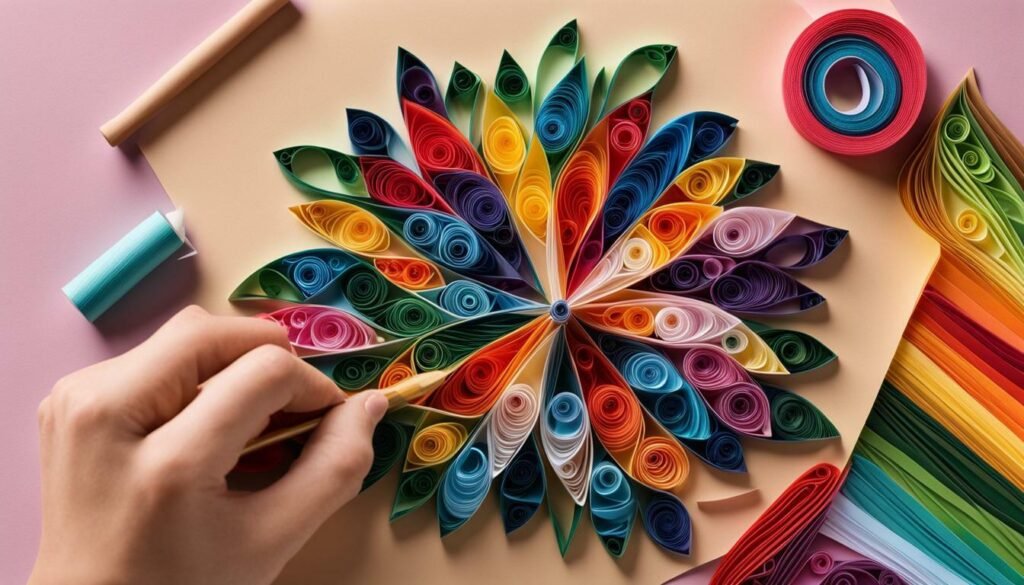
- Cut a piece of cardstock into your desired card size.
- Use markers or stamps to decorate the cardstock with a message or design.
- Choose your quilling colors and design your quilled elements on the quilling board.
- Roll the paper strips with your quilling tool, following the techniques learned in Section 4.
- Glue the quilled elements onto the cardstock, using your design as a guide.
- Let the glue dry completely before handling the card.
Embellish your card:
- Add extra details with markers or glitter glue.
- Create a border using quilled paper strips or a decorative edge punch.
- Add a 3D element by creating a quilled flower or other shape and attaching it with foam tape.
With our quilling tutorial, you have created a unique, handmade card that will surely impress the recipient. Feel free to experiment with different designs and techniques to make each card truly one-of-a-kind.
Quilling Ideas for Inspiration
Ready to unleash your creativity with paper quilling? Here are some quilling ideas to spark your imagination:
- Create quilled greeting cards for any occasion, from birthdays to weddings.
- Make personalized monograms or nameplates for your home or office.
- Design quilled wall art to add a unique touch to your décor.
- Create quilled jewelry, such as earrings, necklaces, and bracelets.
- Make quilled coasters, ornaments, or bookmarks as thoughtful gifts for friends and family.
- Try quilling with unconventional materials, such as fabric or wire.
- Experiment with combining quilling with other crafting techniques, such as embroidery or painting.
Remember, the possibilities are endless with quilling. Don’t be afraid to try new techniques or push the boundaries of traditional quilling.
Looking for more inspiration? Check out quilling books, online tutorials, and quilling communities for ideas and tips from fellow quillers.
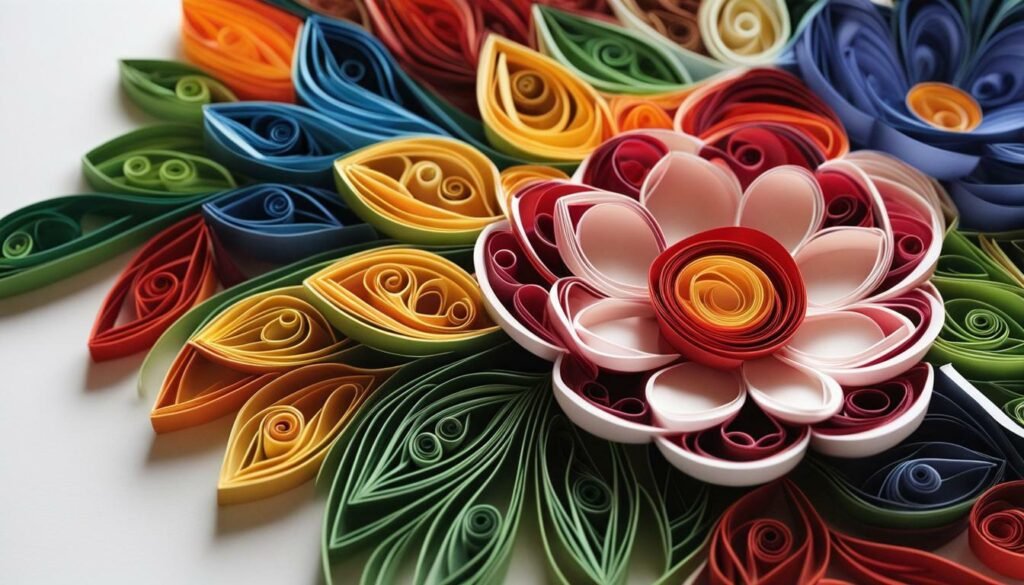
Quilling can be a fun and rewarding hobby that allows you to express your creativity in unique and beautiful ways. Whether you’re a beginner or an experienced quiller, there’s always something new to discover and create. So grab your quilling supplies and start exploring these quilling ideas today!
Troubleshooting Common Quilling Challenges
Quilling can be a rewarding and relaxing hobby, but like any craft, it can come with its own set of challenges. Here are some common issues quillers face and how to solve them.
Issue #1: Unraveling Coils
You may find that your quilled coils are unraveling. This can be caused by using too much or too little glue. It can also happen if you are using low-quality quilling paper.
- Use a fine-tip glue applicator to apply glue evenly to the quilling paper strip.
- Avoid using too much glue, as it can weigh down the paper and cause it to unravel.
- Make sure you are using high-quality quilling paper for best results.
If your coils are still unraveling, try rolling them tighter or letting them dry longer before gluing them together.
Issue #2: Uneven Coils
Your quilled coils may come out uneven, causing your design to look imperfect. This can be caused by not rolling the paper tightly enough or not using a quilling tool.
- Use a quilling tool to create consistently tight coils.
- Roll the paper as tightly as possible without tearing it.
- Practice your technique until you can create even coils every time.
Issue #3: Glue Mishaps
Accidents happen, and sometimes you may accidentally glue your quilled pieces to the wrong spot or smudge glue where you didn’t intend to.
- Use a precision applicator or toothpick to apply small amounts of glue precisely where you need it.
- Keep a damp cloth or Q-tip nearby to quickly wipe away any excess glue before it dries.
- If you accidentally glue a piece in the wrong spot, gently pry it off with a craft knife or tweezers and reposition it.
Quilling can be challenging at times, but with practice and patience, you can overcome these common issues and create stunning quilled designs.

Get inspired by the incredible talent of established quilling artists and see how they push the limits of what can be achieved with paper quilling. These artists showcase their unique creative style and demonstrate the endless possibilities of this mesmerizing craft.
One such artist is Yulia Brodskaya, whose vibrant and intricate paper quilling designs have been featured in numerous exhibitions and publications. Brodskaya has developed her signature style of combining quilling with typography, resulting in stunning three-dimensional works of art.
Another artist to watch is Sena Runa, who has gained a massive following on social media for her whimsical and playful quilled designs. Runa has a talent for transforming everyday objects into delightful quilled creations, such as quilled cacti or fruit slices.
- Yulia Brodskaya’s signature style is combining quilling with typography
- Sena Runa’s creations are whimsical and playful
Finally, we have Ann Martin, who runs the blog “All Things Paper,” which features a wide range of quilling designs from around the world. Martin has a passion for showcasing the versatility of quilling, from traditional designs to contemporary pieces.
Whether you are drawn to the complex designs of Brodskaya, the fun and lighthearted style of Runa, or the diverse range of quilling showcased by Martin, these artists will inspire you to explore new techniques and push the boundaries of your own quilling practice.

Are you eager to connect with other quillers and expand your knowledge of Paper Quilling Basics? Look no further than these resources and communities:
- Quilling Guild: Join this international community of quillers to access workshops, events, and other learning opportunities.
- Quilled Creations: Find inspiration, patterns, and supplies on this website dedicated to quilling.
- Facebook Groups: Search for groups like “Paper Quilling Basics” or “Quilling Inspiration” to connect with fellow quillers and share your creations.
- Instagram Hashtags: Explore popular hashtags like #paperquilling and #quillingart to discover new quilling artists and techniques.
- YouTube Tutorials: Watch step-by-step tutorials from experienced quillers to learn new techniques and refine your skills.
Remember to participate in quilling challenges and contests, and share your own creations to inspire others. Don’t be afraid to ask for feedback and advice from more experienced quillers, as they can offer valuable insights and tips to help you improve your craft.
By engaging with the wider quilling community, you can stay up to date with the latest trends and developments in this exciting craft. Who knows? You may even make some lifelong friends along the way!
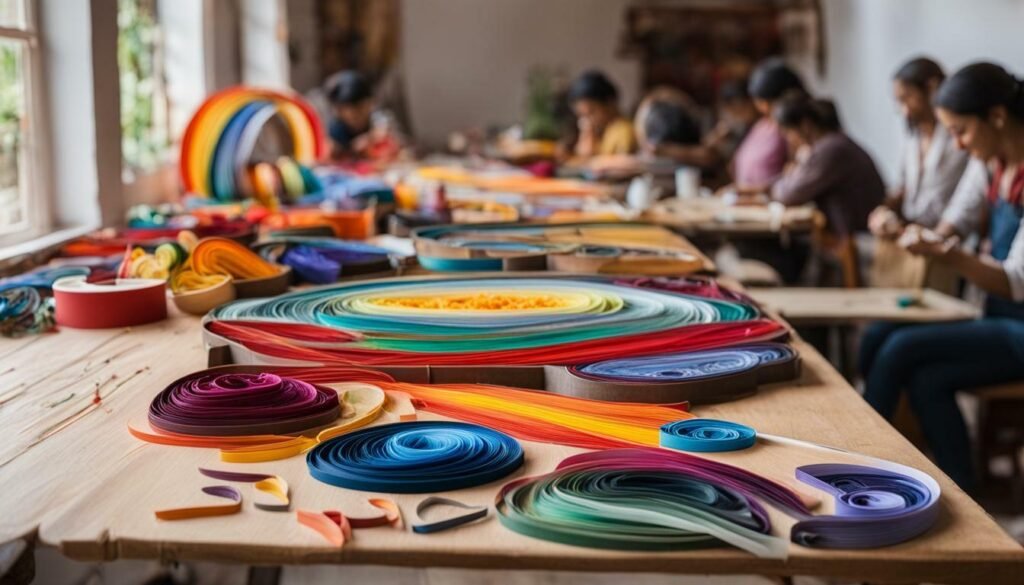
Congratulations on mastering the basics of paper quilling! As you continue to explore this fascinating art form, keep in mind these helpful tips and tricks to enhance your quilling skills:
- Store quilling paper strips in airtight containers to prevent them from becoming brittle or discolored in sunlight.
- Use a comb to create textured effects on quilled pieces, such as hair or fur.
- When creating 3D quilled objects, use a template or mold to ensure consistency in shape and size.
- Try using alternative materials for quilling, such as ribbons, washi tape, or fabric strips, for unique textures and designs.
- To add extra dimension to your quilled pieces, use a quilling mold to create concave or convex shapes.
Don’t be afraid to experiment with different techniques and materials to find your own style in quilling. Remember to have fun and let your creativity flow!

One more thing to note is that it is always helpful to have a designated workspace for your quilling projects. Make sure your tools and supplies are easily accessible and organized, and that your work area has sufficient lighting and ventilation for comfortable crafting.
Additional Tips for Perfecting Your Quilling Skills
- When rolling tight coils, use only a small amount of glue to avoid excess oozing out and sticking to your fingers.
- For intricate quilled designs, use tweezers to manipulate and shape the paper strips with precision.
- Experiment with different types of quilling paper, such as metallic or gradient colors, to add interest and visual appeal to your projects.
- To create symmetrical designs, use a ruler or template to ensure consistency in size and shape.
- When applying glue to your quilled pieces, use a toothpick or small brush for precise application and to avoid excess or messy glue.
By implementing these tips and tricks, you will be on your way to becoming a quilling pro in no time. Keep practicing and pushing yourself to try new things, and you’ll be amazed at the beautiful creations you can make with the art of quilling!
Conclusion: Unleashing Your Artistic Potential
Congratulations on completing this comprehensive guide to Paper Quilling Basics! You now have all the knowledge needed to unleash your artistic potential. Whether you’re a beginner or an expert quiller, it’s always important to remember to have fun and let your imagination run wild.
As you continue your quilling journey, remember to:
- Practice your basic quilling techniques to perfect your skills and create more complicated designs.
- Explore new quilling patterns and designs to keep your creativity flowing.
- Connect with fellow quillers and join online communities to find inspiration and share your unique creations.
- Experiment with different quilling supplies and techniques to create one-of-a-kind projects.
Remember, Paper Quilling Basics is just the beginning. There is no limit to what you can create with paper quilling, so keep exploring, experimenting and developing your skills. With the right tools, supplies, and techniques, you can create beautiful works of art that truly showcase your unique style.
Thank you for joining us on this journey of creativity and self-expression with Paper Quilling Basics. We hope you have enjoyed this guide and have been inspired to embark on your own creative journey. Happy Quilling!
FAQ
Q: What is paper quilling?
A: Paper quilling is an art form that involves rolling, shaping, and gluing strips of paper to create intricate designs and patterns.
Q: How did paper quilling originate?
A: Paper quilling can be traced back to the Renaissance period when nuns and monks would use gilded paper strips to decorate religious artifacts.
Q: What supplies do I need to start paper quilling?
A: To get started with paper quilling, you will need quilling paper strips in various colors, a quilling tool, glue, and a quilling board.
Q: What are some basic quilling techniques?
A: Some basic quilling techniques include rolling tight coils, creating basic shapes like teardrops and marquises, and mastering the art of gluing and securing quilled pieces.
Q: How do I find quilling patterns?
A: There are various sources for quilling patterns, including books, online resources, and quilling communities. You can also create your own patterns based on your imagination and creativity.
Q: Can I create 3D objects with paper quilling?
A: Yes, advanced quilling techniques allow you to create 3D objects, adding depth and dimension to your quilled designs.
Q: Are there any communities or resources for quillers?
A: Yes, there are online communities, forums, and resources dedicated to quilling where you can connect with fellow quillers, find inspiration, and participate in challenges and contests.
Q: How do I troubleshoot common quilling challenges?
A: Common quilling challenges such as unraveling coils or glue mishaps can be overcome by following expert tips and tricks. Additionally, learning from experienced quillers can help you avoid common pitfalls.
Q: Can I incorporate quilling into other crafts?
A: Absolutely! Quilling can be incorporated into various crafts such as cards, framed art, jewelry, and home decor, allowing you to add a unique touch of quilled beauty to your creations.
Q: How can I unleash my artistic potential through paper quilling?
A: By practicing, experimenting with new techniques, and expressing your unique artistic vision, you can unleash your creativity and explore the endless possibilities of paper quilling.
